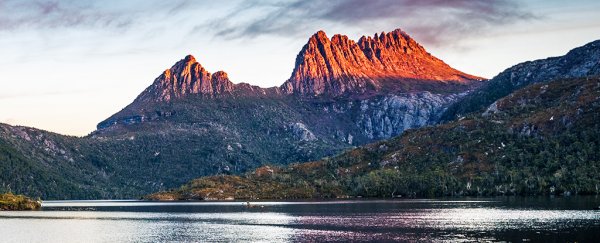Geologically speaking, Australia is a relatively quiet place to live. Earthquakes are rare and typically gentle, and as for volcanoes, there hasn't been as much as a burp of magma on the mainland in thousands of years.
It wasn't always this way. In fact, the land is littered with the remains of mysterious eruptions that shattered the crust with surprising regularity over the past 80 million years.
A new study suggests some of the more unusual periods of activity were the result of an ancient seafloor squeezing its way beneath the plate, providing the perfect batter for an extensive course of eruptions right down the length of the continent.
From the sheer cliffs of Cradle Mountain in Tasmania to Victoria's famous Organ Pipes, to the dramatic peaks of the Glass House Mountains in Queensland, a stunning array of monoliths line Australia's east coast like a crooked spine.
Exactly what caused them isn't at all obvious.
"We aren't on the famous Pacific 'Ring of Fire' that produces so many volcanoes and earthquakes," says geoscientist Ben Mather from the University of Sydney.
"So, we needed another explanation why there have been so many volcanoes on Australia's east coast."
In many parts of the world, far from the edges of any tectonic plates, volcanoes are the product of rising heat scorching the crust. As the crust slides across patches of high temperature, weaknesses can channel rising magma to the surface.
Yet hot spot volcanoes tend to look like ellipses dotting the landscape. Many of Australia's volcanoes are solitary pillars – standing alone in the middle of nowhere.
"Rather than huge explosions like Krakatoa or Vesuvius, or iconic volcanoes like Mount Fuji, the effect is more like the bubbles emerging as you heat your pancake mix," says Mather.
An alternative mechanism might lie in pockets of explosive chemistry.
Volatile mixes of material can react to form gases that push up through weak parts of the continent, generating volcanoes just like many of those we find across Australia.
It's a solid hypothesis with good evidence to support it, but leaves open the question of where such mixtures might have originated in the first place.
Maybe swirls of molten rock dredged them up as one continent slid beneath another, or perhaps churning currents in the mantle rubbed off lower sections of crust. These events might explain several million years of volcanism covering a strip of land right at the knife's edge of a sinking piece of crust.
To cover 100 million years of volcanic history, we're going to need a wide-ranging model with staying-power.
What's more, it would also need to explain similar volcanoes dotting the surface of its underwater neighbour, the 'lost' continent of Zealandia.
This volcanic 'spine' in fact spreads across a 5,000-kilometre (3,100-mile) wide section of Earth's crust.
None of the going theories has a hope of explaining all of that.
Fortunately, this vast period of geological activity aligns neatly with the sinking of a large section of the Pacific plate far to Australia's east, starting at the Tonga-Kermadec Trench to the east and north of New Zealand.
Thousands of kilometres of the seabed are slowly being shoved under Australia's continental shelf, dragging with them a rich icing of volatile minerals laid down by marine life, back when dinosaurs stomped around.
"What sets the east Australia-Zealandia region apart is that the sea-floor being pushed under the continent from the western Pacific is highly concentrated with hydrous materials and carbon-rich rocks," says Mather.
"This creates a transition zone right under the east coast of Australia that is enriched with volatile materials."
The theory explains not just periods of volcanic activity dating back many millions of years, but the scale of its reach deep into the continent's interior.
Finding ample evidence to back the theory up isn't easy, given we're yet to get suitable coverage of seismic sensors across Zealandia and eastern Australia. But the researchers are confident that what data we do have is in line with this new model.
Isotopes collected from volcanic rock formations down the coast also match the kinds of signatures expected from thick layers of goop on the ocean floor being cooked in the mantle.
"The peaks of volcanic activity correlate nicely with the amount of seafloor being recycled at the Tonga-Kermadec trench east of New Zealand," says Mather.
It's not just Australia's geological history demanding an explanation; the theory could be used to explain similar fields of activity around the world, including eastern China and the western US.
Whether Australia can expect new explosive formations in the near future isn't clear. With a belly full of volcano batter, it's possible its days of geological activity are far from over.
This research was published in Science Advances.
